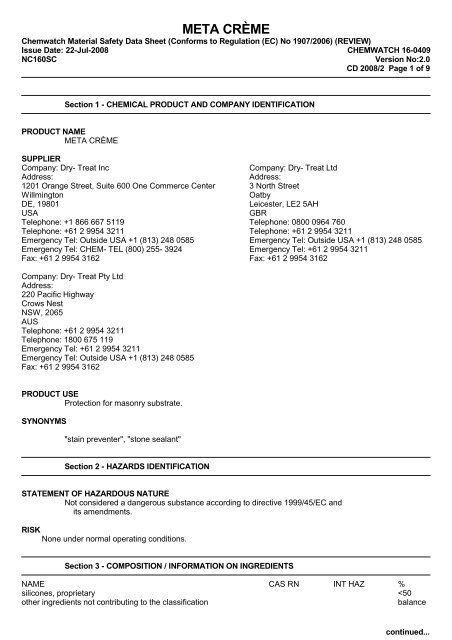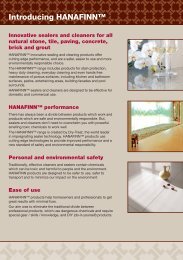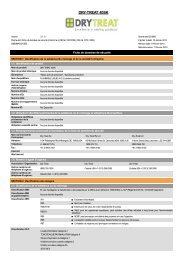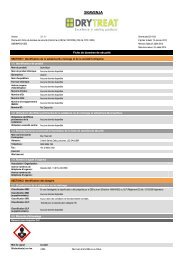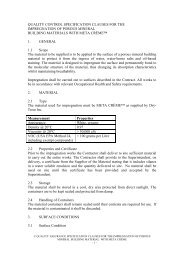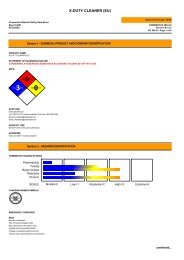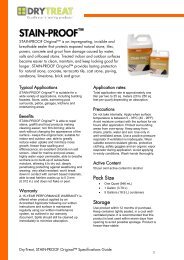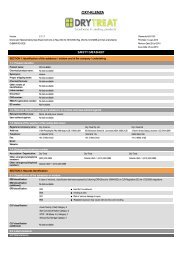meta crème - Pure Adhesion
meta crème - Pure Adhesion
meta crème - Pure Adhesion
You also want an ePaper? Increase the reach of your titles
YUMPU automatically turns print PDFs into web optimized ePapers that Google loves.
META CRÈME<br />
Chemwatch Material Safety Data Sheet (Conforms to Regulation (EC) No 1907/2006) (REVIEW)<br />
Issue Date: 22-Jul-2008 CHEMWATCH 16-0409<br />
NC160SC Version No:2.0<br />
CD 2008/2 Page 1 of 9<br />
Section 1 - CHEMICAL PRODUCT AND COMPANY IDENTIFICATION<br />
PRODUCT NAME<br />
META CRÈME<br />
SUPPLIER<br />
Company: Dry- Treat Inc Company: Dry- Treat Ltd<br />
Address: Address:<br />
1201 Orange Street, Suite 600 One Commerce Center 3 North Street<br />
Willmington Oatby<br />
DE, 19801 Leicester, LE2 5AH<br />
USA GBR<br />
Telephone: +1 866 667 5119 Telephone: 0800 0964 760<br />
Telephone: +61 2 9954 3211 Telephone: +61 2 9954 3211<br />
Emergency Tel: Outside USA +1 (813) 248 0585 Emergency Tel: Outside USA +1 (813) 248 0585<br />
Emergency Tel: CHEM- TEL (800) 255- 3924 Emergency Tel: +61 2 9954 3211<br />
Fax: +61 2 9954 3162 Fax: +61 2 9954 3162<br />
Company: Dry- Treat Pty Ltd<br />
Address:<br />
220 Pacific Highway<br />
Crows Nest<br />
NSW, 2065<br />
AUS<br />
Telephone: +61 2 9954 3211<br />
Telephone: 1800 675 119<br />
Emergency Tel: +61 2 9954 3211<br />
Emergency Tel: Outside USA +1 (813) 248 0585<br />
Fax: +61 2 9954 3162<br />
PRODUCT USE<br />
Protection for masonry substrate.<br />
SYNONYMS<br />
"stain preventer", "stone sealant"<br />
Section 2 - HAZARDS IDENTIFICATION<br />
STATEMENT OF HAZARDOUS NATURE<br />
Not considered a dangerous substance according to directive 1999/45/EC and<br />
its amendments.<br />
RISK<br />
None under normal operating conditions.<br />
Section 3 - COMPOSITION / INFORMATION ON INGREDIENTS<br />
NAME CAS RN INT HAZ %<br />
silicones, proprietary
META CRÈME<br />
Chemwatch Material Safety Data Sheet (Conforms to Regulation (EC) No 1907/2006) (REVIEW)<br />
Issue Date: 22-Jul-2008 CHEMWATCH 16-0409<br />
NC160SC Version No:2.0<br />
CD 2008/2 Page 2 of 9<br />
Section 4 - FIRST AID MEASURES<br />
SWALLOWED<br />
· Immediately give a glass of water.<br />
· First aid is not generally required. If in doubt, contact a Poisons Information Centre<br />
or a doctor.<br />
EYE<br />
SKIN<br />
If this product comes in contact with eyes:<br />
· Wash out immediately with water.<br />
· If irritation continues, seek medical attention.<br />
· Removal of contact lenses after an eye injury should only be undertaken by skilled<br />
personnel.<br />
If skin or hair contact occurs:<br />
· Flush skin and hair with running water (and soap if available).<br />
· Seek medical attention in event of irritation.<br />
INHALED<br />
· If fumes or combustion products are inhaled remove from contaminated area.<br />
· Other measures are usually unnecessary.<br />
NOTES TO PHYSICIAN<br />
Treat symptomatically.<br />
Section 5 - FIRE FIGHTING MEASURES<br />
EXTINGUISHING MEDIA<br />
· Water spray or fog.<br />
· Foam.<br />
· Dry chemical powder.<br />
· BCF (where regulations permit).<br />
· Carbon dioxide.<br />
FIRE FIGHTING<br />
· Alert Fire Brigade and tell them location and nature of hazard.<br />
· Wear breathing apparatus plus protective gloves.<br />
· Prevent, by any means available, spillage from entering drains or water courses.<br />
· Use water delivered as a fine spray to control fire and cool adjacent area.<br />
· DO NOT approach containers suspected to be hot.<br />
· Cool fire exposed containers with water spray from a protected location.<br />
· If safe to do so, remove containers from path of fire.<br />
· Equipment should be thoroughly decontaminated after use.<br />
FIRE/EXPLOSION HAZARD<br />
· High temperature decomposition products include silicon dioxide, small amounts of<br />
formaldehyde, formic acid, acetic acid and traces of silicon polymers.<br />
· These gases may ignite and, depending on circumstances, may cause the resin/polymer to<br />
ignite.<br />
· An outer skin of silica may also form. Extinguishing of fire, beneath the skin, may be<br />
difficult.<br />
· Combustible.<br />
· Slight fire hazard when exposed to heat or flame.<br />
· Heating may cause expansion or decomposition leading to violent rupture of containers.<br />
· On combustion, may emit toxic fumes of carbon monoxide (CO).<br />
continued...
META CRÈME<br />
Chemwatch Material Safety Data Sheet (Conforms to Regulation (EC) No 1907/2006) (REVIEW)<br />
Issue Date: 22-Jul-2008 CHEMWATCH 16-0409<br />
NC160SC Version No:2.0<br />
CD 2008/2 Page 3 of 9<br />
Section 5 - FIRE FIGHTING MEASURES<br />
· May emit acrid smoke.<br />
· Mists containing combustible materials may be explosive.<br />
Combustion products include: carbon dioxide (CO2), silicon dioxide (SiO2), other<br />
pyrolysis products typical of burning organic material.<br />
May emit poisonous fumes.<br />
FIRE INCOMPATIBILITY<br />
· Avoid contamination with oxidising agents i.e. nitrates, oxidising acids, chlorine<br />
bleaches, pool chlorine etc. as ignition may result.<br />
PERSONAL PROTECTION<br />
Glasses:<br />
Safety Glasses.<br />
Chemical goggles.<br />
Gloves:<br />
PVC chemical resistant type.<br />
Respirator:<br />
Type AK- P Filter of sufficient capacity<br />
Section 6 - ACCIDENTAL RELEASE MEASURES<br />
MINOR SPILLS<br />
Slippery when spilt.<br />
· Remove all ignition sources.<br />
· Clean up all spills immediately.<br />
· Avoid breathing vapours and contact with skin and eyes.<br />
· Control personal contact by using protective equipment.<br />
· Contain and absorb spill with sand, earth, inert material or vermiculite.<br />
· Wipe up.<br />
· Place in a suitable labelled container for waste disposal.<br />
MAJOR SPILLS<br />
Slippery when spilt.<br />
Moderate hazard.<br />
· Clear area of personnel and move upwind.<br />
· Alert Fire Brigade and tell them location and nature of hazard.<br />
· Wear breathing apparatus plus protective gloves.<br />
· Prevent, by any means available, spillage from entering drains or water course.<br />
· No smoking, naked lights or ignition sources.<br />
· Increase ventilation.<br />
· Stop leak if safe to do so.<br />
· Contain spill with sand, earth or vermiculite.<br />
· Collect recoverable product into labelled containers for recycling.<br />
· Absorb remaining product with sand, earth or vermiculite.<br />
· Collect solid residues and seal in labelled drums for disposal.<br />
· Wash area and prevent runoff into drains.<br />
· If contamination of drains or waterways occurs, advise emergency services.<br />
Section 7 - HANDLING AND STORAGE<br />
PROCEDURE FOR HANDLING<br />
· Avoid all personal contact, including inhalation.<br />
· Wear protective clothing when risk of exposure occurs.<br />
· Use in a well-ventilated area.<br />
continued...
META CRÈME<br />
Chemwatch Material Safety Data Sheet (Conforms to Regulation (EC) No 1907/2006) (REVIEW)<br />
Issue Date: 22-Jul-2008 CHEMWATCH 16-0409<br />
NC160SC Version No:2.0<br />
CD 2008/2 Page 4 of 9<br />
Section 7 - HANDLING AND STORAGE<br />
· Prevent concentration in hollows and sumps.<br />
· DO NOT enter confined spaces until atmosphere has been checked.<br />
· DO NOT allow material to contact humans, exposed food or food utensils.<br />
· Avoid contact with incompatible materials.<br />
· When handling, DO NOT eat, drink or smoke.<br />
· Keep containers securely sealed when not in use.<br />
· Avoid physical damage to containers.<br />
· Always wash hands with soap and water after handling.<br />
· Work clothes should be laundered separately. Launder contaminated clothing before reuse.<br />
· Use good occupational work practice.<br />
· Observe manufacturer's storing and handling recommendations.<br />
· Atmosphere should be regularly checked against established exposure standards to ensure<br />
safe working conditions are maintained.<br />
SUITABLE CONTAINER<br />
· Metal can or drum<br />
· Packaging as recommended by manufacturer.<br />
· Check all containers are clearly labelled and free from leaks.<br />
STORAGE INCOMPATIBILITY<br />
· Avoid reaction with oxidising agents.<br />
STORAGE REQUIREMENTS<br />
· Store in original containers.<br />
· Keep containers securely sealed.<br />
· No smoking, naked lights or ignition sources.<br />
· Store in a cool, dry, well-ventilated area.<br />
· Store away from incompatible materials and foodstuff containers.<br />
· Protect containers against physical damage and check regularly for leaks.<br />
· Observe manufacturer's storing and handling recommendations.<br />
Section 8 - EXPOSURE CONTROLS / PERSONAL PROTECTION<br />
EXPOSURE CONTROLS<br />
MATERIAL DATA<br />
For ethanol:<br />
Odour Threshold Value: 49-716 ppm (detection), 101 ppm (recognition)<br />
Eye and respiratory tract irritation do not appear to occur at exposure levels of less<br />
than 5000 ppm and the TLV-TWA is thought to provide an adequate margin of safety against<br />
such effects. Experiments in man show that inhalation of 1000 ppm caused slight symptoms<br />
of poisoning and 5000 ppm caused strong stupor and morbid sleepiness. Subjects exposed to<br />
5000 ppm to 10000 ppm experienced smarting of the eyes and nose and coughing. Symptoms<br />
disappeared within minutes. Inhalation also causes local irritating effects to the eyes<br />
and upper respiratory tract, headaches, sensation of heat intraocular tension, stupor,<br />
fatigue and a need to sleep. At 15000 ppm there was continuous lachrymation and coughing.<br />
PERSONAL PROTECTION<br />
EYE<br />
· Safety glasses with side shields<br />
· Chemical goggles.<br />
· Contact lenses may pose a special hazard; soft contact lenses may absorb and<br />
continued...
META CRÈME<br />
Chemwatch Material Safety Data Sheet (Conforms to Regulation (EC) No 1907/2006) (REVIEW)<br />
Issue Date: 22-Jul-2008 CHEMWATCH 16-0409<br />
NC160SC Version No:2.0<br />
CD 2008/2 Page 5 of 9<br />
Section 8 - EXPOSURE CONTROLS / PERSONAL PROTECTION<br />
concentrate irritants. A written policy document, describing the wearing of lens or<br />
restrictions on use, should be created for each workplace or task. This should include a<br />
review of lens absorption and adsorption for the class of chemicals in use and an account<br />
of injury experience. Medical and first-aid personnel should be trained in their removal<br />
and suitable equipment should be readily available. In the event of chemical exposure,<br />
begin eye irrigation immediately and remove contact lens as soon as practicable. Lens<br />
should be removed at the first signs of eye redness or irritation - lens should be<br />
removed in a clean environment only after workers have washed hands thoroughly. [CDC<br />
NIOSH Current Intelligence Bulletin 59].<br />
HANDS/FEET<br />
Suitability and durability of glove type is dependent on usage. Factors such as:<br />
· frequency and duration of contact,<br />
· chemical resistance of glove material,<br />
· glove thickness and<br />
· dexterity,<br />
are important in the selection of gloves.<br />
· Wear chemical protective gloves, eg. PVC.<br />
· Wear safety footwear or safety gumboots, eg. Rubber.<br />
OTHER<br />
· Overalls.<br />
· P.V.C. apron.<br />
· Barrier cream.<br />
· Skin cleansing cream.<br />
· Eye wash unit.<br />
ENGINEERING CONTROLS<br />
General exhaust is adequate under normal operating conditions. If risk of overexposure<br />
exists, wear SAA approved respirator. Correct fit is essential to obtain adequate<br />
protection. Provide adequate ventilation in warehouse or closed storage areas.<br />
Section 9 - PHYSICAL AND CHEMICAL PROPERTIES<br />
PHYSICAL PROPERTIES<br />
Liquid.<br />
Mixes with water.<br />
Molecular Weight: Not Applicable Boiling Range (°C): Not Av ailable<br />
Melting Range (°C): Not Available Specific Gravity (water= 1): 1.0<br />
Solubility in water (g/L): Miscible pH (as supplied): 8.0<br />
pH (1% solution): Not Available Vapour Pressure (kPa): Not Available<br />
Volatile Component (%vol): Not Available Evaporation Rate: Not Available<br />
Relative Vapour Density (air=1): Not Available Flash Point (°C): Not Available<br />
Lower Explosive Limit (%): Not Available Upper Explosive Limit (%): Not Available<br />
Autoignition Temp (°C): Not Available Decomposition Temp ( °C): Not Available<br />
State: Liquid Viscosity: Not Available<br />
EUCLID Remarks<br />
APPEARANCE<br />
Liquid with a characteristic odour; mixes with water.<br />
continued...
META CRÈME<br />
Chemwatch Material Safety Data Sheet (Conforms to Regulation (EC) No 1907/2006) (REVIEW)<br />
Issue Date: 22-Jul-2008 CHEMWATCH 16-0409<br />
NC160SC Version No:2.0<br />
CD 2008/2 Page 6 of 9<br />
Section 10 - CHEMICAL STABILITY AND REACTIVITY INFORMATION<br />
CONDITIONS CONTRIBUTING TO INSTABILITY<br />
· Presence of incompatible materials.<br />
· Product is considered stable.<br />
· Hazardous polymerisation will not occur.<br />
Section 11 - TOXICOLOGICAL INFORMATION<br />
POTENTIAL HEALTH EFFECTS<br />
ACUTE HEALTH EFFECTS<br />
SWALLOWED<br />
The material has NOT been classified by EC Directives or other classification systems as<br />
"harmful by ingestion". This is because of the lack of corroborating animal or human<br />
evidence. The material may still be damaging to the health of the individual, following<br />
ingestion, especially where pre-existing organ (eg. liver, kidney) damage is evident.<br />
Present definitions of harmful or toxic substances are generally based on doses producing<br />
mortality rather than those producing morbidity (disease, ill-health). Gastrointestinal<br />
tract discomfort may produce nausea and vomiting. In an occupational setting however,<br />
ingestion of insignificant quantities is not thought to be cause for concern.<br />
EYE<br />
Although the liquid is not thought to be an irritant (as classified by EC Directives),<br />
direct contact with the eye may produce transient discomfort characterised by tearing or<br />
conjunctival redness (as with windburn).<br />
SKIN<br />
The material is not thought to produce adverse health effects or skin irritation<br />
following contact (as classified by EC Directives using animal models). Nevertheless,<br />
good hygiene practice requires that exposure be kept to a minimum and that suitable<br />
gloves be used in an occupational setting.<br />
Open cuts, abraded or irritated skin should not be exposed to this material.<br />
Entry into the blood-stream, through, for example, cuts, abrasions or lesions, may<br />
produce systemic injury with harmful effects. Examine the skin prior to the use of the<br />
material and ensure that any external damage is suitably protected.<br />
INHALED<br />
Not normally a hazard due to non-volatile nature of product.<br />
The material is not thought to produce adverse health effects or irritation of the<br />
respiratory tract (as classified by EC Directives using animal models). Nevertheless,<br />
good hygiene practice requires that exposure be kept to a minimum and that suitable<br />
control measures be used in an occupational setting.<br />
CHRONIC HEALTH EFFECTS<br />
Substance accumulation, in the human body, may occur and may cause some concern following<br />
repeated or long-term occupational exposure.<br />
Prolonged exposure to ethanol may cause damage to the liver and cause scarring. It may<br />
also worsen damage caused by other agents. Large amounts of ethanol taken in pregnancy<br />
may result in "foetal alcohol syndrome", characterised by delay in mental and physical<br />
development, learning difficulties, behavioural problems and small head size. A small<br />
number of people develop allergic reactions to ethanol, which include eye infections,<br />
skin swelling, shortness of breath, and itchy rashes with blisters.<br />
continued...
META CRÈME<br />
Chemwatch Material Safety Data Sheet (Conforms to Regulation (EC) No 1907/2006) (REVIEW)<br />
Issue Date: 22-Jul-2008 CHEMWATCH 16-0409<br />
NC160SC Version No:2.0<br />
CD 2008/2 Page 7 of 9<br />
Section 11 - TOXICOLOGICAL INFORMATION<br />
META CRÈME<br />
TOXICITY AND IRRITATION<br />
The material may be irritating to the eye, with prolonged contact causing inflammation.<br />
Repeated or prolonged exposure to irritants may produce conjunctivitis.<br />
The material may cause skin irritation after prolonged or repeated exposure and may<br />
produce on contact skin redness, swelling, the production of vesicles, scaling and<br />
thickening of the skin.<br />
Section 12 - ECOLOGICAL INFORMATION<br />
DO NOT discharge into sewer or waterways.<br />
Section 13 - DISPOSAL CONSIDERATIONS<br />
Legislation addressing waste disposal requirements may differ by country, state and/ or<br />
territory. Each user must refer to laws operating in their area. In some areas, certain<br />
wastes must be tracked.<br />
A Hierarchy of Controls seems to be common - the user should investigate:<br />
· Reduction,<br />
· Reuse<br />
· Recycling<br />
· Disposal (if all else fails)<br />
This material may be recycled if unused, or if it has not been contaminated so as to make<br />
it unsuitable for its intended use. If it has been contaminated, it may be possible to<br />
reclaim the product by filtration, distillation or some other means. Shelf life<br />
considerations should also be applied in making decisions of this type. Note that<br />
properties of a material may change in use, and recycling or reuse may not always be<br />
appropriate.<br />
· DO NOT allow wash water from cleaning or process equipment to enter drains.<br />
· It may be necessary to collect all wash water for treatment before disposal.<br />
· In all cases disposal to sewer may be subject to local laws and regulations and these<br />
should be considered first.<br />
· Where in doubt contact the responsible authority.<br />
· Recycle wherever possible or consult manufacturer for recycling options.<br />
· Consult State Land Waste Authority for disposal.<br />
· Bury or incinerate residue at an approved site.<br />
· Recycle containers if possible, or dispose of in an authorised landfill.<br />
According to the European Waste Catalogue, Waste Codes are not product specific but<br />
application specific. Waste Codes should be assigned by the User based on the application<br />
in which the product is used.<br />
Section 14 - TRANSPORTATION INFORMATION<br />
HAZCHEM: None<br />
NOT REGULATED FOR TRANSPORT OF DANGEROUS GOODS:ADR, IATA,<br />
IMDG<br />
continued...
META CRÈME<br />
Chemwatch Material Safety Data Sheet (Conforms to Regulation (EC) No 1907/2006) (REVIEW)<br />
Issue Date: 22-Jul-2008 CHEMWATCH 16-0409<br />
NC160SC Version No:2.0<br />
CD 2008/2 Page 8 of 9<br />
Section 15 - REGULATORY INFORMATION<br />
RISK<br />
None under normal operating conditions.<br />
SAFETY<br />
REGULATIONS<br />
META CRÈME (CAS: None):<br />
No regulations applicable<br />
Safety Codes Safety Phrases<br />
S23 Do not breathe gas/ fumes/ vapour/ spray.<br />
S24 Avoid contact with skin.<br />
This safety data sheet is in compliance with the following EU legislation and its<br />
adaptations – as far as applicable - : 67/548/EEC, 1999/45/EC, 76/769/EEC, 98/24/EC,<br />
92/85/EEC, 94/33/EC, 91/689/EEC, 1999/13/EC, as well as the following British legislation:<br />
- The Control of Substances Hazardous to Health Regulations (COSHH) 2002 - COSHH<br />
Essentials - The Management of Health and Safety at Work Regulations 1999<br />
Section 16 - OTHER INFORMATION<br />
EXPOSURE STANDARD FOR MIXTURES<br />
"Worst Case" computer-aided prediction of vapour components/concentrations:<br />
Composite Exposure Standard for Mixture (TWA) (mg/m3): 74.7965 mg/m³<br />
If the breathing zone concentration of ANY of the components listed below is exceeded,<br />
"Worst Case" considerations deem the individual to be overexposed.<br />
Component Breathing Zone ppm Breathing Zone mg/m3 Mixture Conc: (%).<br />
Component Breathing zone Breathing Zone Mixture Conc<br />
(ppm) (mg/m³) (%)<br />
octamethylcyclotetrasiloxane 0.07 0.8138 0.6<br />
decamethylcyclopentasiloxane 4.93 73.9827 50.0<br />
Operations which produce a spray/mist or fume/dust, introduce particulates to the<br />
breathing zone.<br />
If the breathing zone concentration of ANY of the components listed below is exceeded,<br />
"Worst Case" considerations deem the individual to be overexposed.<br />
At the "Composite Exposure Standard for Mixture" (TWA) (mg/m3): 74.7965 mg/m³<br />
Classification of the preparation and its individual components has drawn on official and<br />
authoritative sources as well as independent review by the Chemwatch Classification<br />
committee using available literature references.<br />
A list of reference resources used to assist the committee may be found at:<br />
www.chemwatch.net/references.<br />
The (M)SDS is a Hazard Communication tool and should be used to assist in the Risk<br />
Assessment. Many factors determine whether the reported Hazards are Risks in the<br />
workplace or other settings. Risks may be determined by reference to Exposures Scenarios.<br />
Scale of use, frequency of use and current or available engineering controls must be<br />
considered.<br />
For detailed advice on Personal Protective Equipment, refer to the following EU CEN<br />
continued...
META CRÈME<br />
Chemwatch Material Safety Data Sheet (Conforms to Regulation (EC) No 1907/2006) (REVIEW)<br />
Issue Date: 22-Jul-2008 CHEMWATCH 16-0409<br />
NC160SC Version No:2.0<br />
CD 2008/2 Page 9 of 9<br />
Section 16 - OTHER INFORMATION<br />
Standards:<br />
EN 16 Personal eye-protection<br />
EN 340 Protective clothing<br />
EN 374 Protective gloves against chemicals and micro-organisms<br />
EN 13832 Footwear protecting against chemicals<br />
EN 133 Respiratory protective devices.<br />
This document is copyright. Apart from any fair dealing for the purposes of<br />
private study, research, review or criticism, as permitted under the Copyright<br />
Act, no part may be reproduced by any process without written permission from<br />
CHEMWATCH. TEL (+61 3) 9572 4700.<br />
Issue Date: 22-Jul-2008<br />
Print Date: 22-Jul-2008


